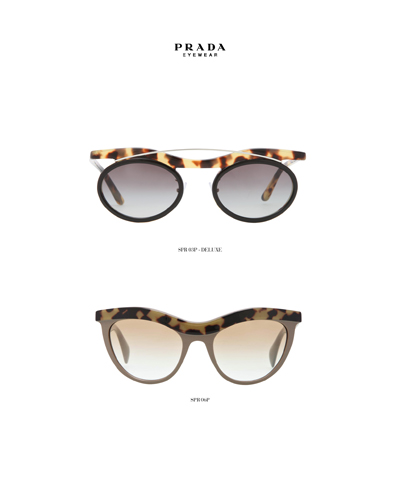The eyewear market is turning its sights to the Middle East for growth, according to a new report by Transparency Market Research.
Through 2023, the Middle East’s growing class will propel the eyewear market to an 8.8 percent compound annual growth rate, with luxury brands comprising a large share. The Middle East’s growing middle class, fashion sense and general eye for luxury will buoy sector growth.
For the “Middle East Eyewear Market" report, markets are broken up as follows: Egypt, United Arab Emirates, Qatar, Oman, Kuwait, Bahrain, Jordan, Lebanon, Turkey and the “rest of the Middle East.” Spectacle lenses and frames, soft and rigid contact lenses and polarized and non-polarized sunglasses are all considered.
Future's so bright
Luxury eyewear already has a disproportionately high share of the eyewear market across the Middle East. Luxottica holds more than 40 percent of the market share in most of its nations, including the United Arab Emirates, which hosts more than a third of the region’s total market.
Following the UAE, which is currently a $1 billion market, are Saudi Arabia and Turkey, at around two-thirds and one-third the market size of the UAE. Oman, Kuwait, Qatar and Egypt follow.

Prada sunglasses
Assuming the forecasted 8.8 percent CAGR, the market will grow to $5.86 billion by 2023. Over the same period, volume CAGR will be 4.8 percent, with the gap in relative growth rates indicating the growing popularity of luxury eyewear.
Diagnoses of acute myopia in the Middle East are increasing, and contact lenses and spectacle lenses are becoming more popular. These trends, along with a growing purchasing power parity and income create opportunities for eyewear brands and licensors to exploit.
In particular, spectacles are growing quickly in volume and market valuation, at 61 percent and 75 percent, respectively, in 2014.

Jimmy Choo Vivy Sunglasses
Conversely, a preference among some subgroups for corrective surgery is growing. While such treatment could hinder the growth of the eyewear market, its extremely high costs would limit it among all but the highest end.
Since a growing middle class will spur much of the growth, and because spectacles and sunglasses are fashion items rather than purely functional accessories, the growth of laser eye and other surgeries looks to be minimal.
Gotta wear these shades
While the emergence of the Middle East represents one potential growth market, some manufacturers and distributors are looking to established marketplaces to continue growing.
For example, Italy’s Safilo Group, which manufactures and distributes eyewear for licensed brands including Fendi and Dior, appointed Henri Blomqvist as its new CEO of North America.
Mr. Blomqvist has worked for Safilo for three years as its chief commercial officer, during which he redeveloped the group’s go-to-market strategy, centering his efforts on boosting sustainability and quality of distribution. This new hire is part of Safilo’s 2020 plan, which aims to establish leadership in key markets around the globe, one of which is North America (see story).
With optimism filling the eyewear market, new brands are taking notice and looking to carve out a space in the category.
Last month, Swiss watchmaker Omega brought its brand aesthetic to the category through a partnership with eyewear licensee Marcolin Group.
The brands have produced an exclusive collection of Omega branded sunglasses, a popular category due to its entry-level price point. The first collection, available only at Omega boutiques, will launch this August, just as the watchmaker’s role as the official timekeeper of the Summer Olympics kicks off (see story).
{"ct":"+lZAEt92Tx5u+DtSDF6557+c4ebYeJIBgd1aojgxSTsq+Fgnoja1OL+6QfuWBJ+Ru2WnVr3r8SS9aWl560Eb5+k+yLBsXwVAcaWoVAkAFk42aBWbuDoDiHbymyfmz\/5qNzeppIxpFy\/JzhLxM0t8v9kaNPR59li+\/i1hJjrqvOh1p9J1sYGUTBExQKDdVRIuZ95EWjCfTuB7in+baopo48GcKbvwH4xFQlpANMAonmAHTfeimECHmC5dZd2SSBL3etLPK5F+UhBl6ZPa4HMLJ9A+ZA\/vQlJaEOx9SE3Gh6i7Oe7d71dlD\/nXkPQfWw2eAUdJf+T1qOjs\/J\/7oxZcfqDfe6u6wF31o7xonFsVbIkIRReIktmj9YH9Rc7yT2SEq7WT4DNXvNP8ZCouKgd498fCMQYXJmMw5RSn59e\/aHp3GbeOBc6tK4MKto2rGnIMmL6QeTu6bqOYINpgaUqcqMJ1ttD5CBt2YkLyzRtwr8OqN7R83dHJ8dH+u\/HY6HYcPOskDYhmZ0lz9WX9MqPGxEacxsypOiu+JdIn87cw9u7GbUMGQp3vpBMSXLAthNkMmlcHKVKCh\/vs95nI537F\/2GU1RX\/yvnLhD3iEKg\/coj2yCtySU6gjIur61ZBV8SEqmM211jQtXFu\/j6X7wtM7j3C58F0+TQwH1jruyyvtJCp9tR4CmR65l9kv28YdMibzDNMCr8Rx4EhdfwOG9EEF\/X\/4Eyjh6IwRI7snZ2uwNwwr9lWzn6plLMq9EQg2JEx7HzFHzpWDZnNwuFmVmSFBeMh2qNyy8qN3tk5\/iZNbaLYYKCcbpJ2WkT+4feR5+z0IgAQ1Bd+eIOcARzcP0Xac6TAgEZZXiXWIAWPzTneGCjovVVgt\/bFAW5E8CcZbx1xURxzUGJXCBaZ\/0u2SdCey6zCLwqmy5ttIMlhDwvvxPfNZE3cE1XFe24rbCXIJneex9TKHIkb\/7MHlsE6grKhWkYgt48Tue6nXe8\/WX1qd6pABSvJ4tzFGhvTKDE1F9ejNmIC34GM7ES4Sl+dJuDgE+GtBFobUXqUqTWBbWjPtfndZmiqnCEiuD3I4tG984NvPHpRfGLLVT4hUCnlDKMifWffwUKUQMxCxC41UKeKhCY43BUtzJn9ZPS42fHedxIAIkX\/WDkreVUH9vWbwUgPI2LkJGu0lqVKGvihnK1hZkMbwbvQDEg50BQ\/ovHANr8Nt6bL79U9782M6YoZqE1UgyqTf5s41Llddtris79dF0BeUU3uqSWIYpfNGbWHcbp27L5qMYXkkrmsJLWHBpqCn0E1DUkZ6iG3WNgsQR+aNf4R\/JTsjhHgRr9hJKlvLYQum95CtZV6NzbxRyRoMNofe1JDwcyps\/h4LNOjngi51b3Cz84cmA1clhsnXsRXJX27QJvD67tOPNdBrBDE4Lp8d6kP5riUj\/p1uj7lPqtjhVNomtopktOQ\/lK4YpXxA9pYsQv\/ZkCNQ0+n7kloqKptVHj1I5OJR8WzTfAmkYMtl8\/0SNBbVowfxtEV4j+jPpQMk8\/gN9Q6Flr039UyRfN2vb7aWh52KGad+sLkclCJDHRv9sSV+voXZjnAj08gT1GKf2mhepGar+g6S8DSzvO02rCJPpZLV9Sq3VK0af+ZSESRDMwoUoG9Ta9DiwF3j7pgdNcLjTT0mZ1ODG+TB6wGUOEfs\/BLZn+hnCZFex1DlmXeiWeUpNE3whYAVTrUzxZe8MiE0u0x8NHSkFmQEoKZdOeFksZDMfLVbB5uxKhrcXQNwvi4ZFLXnQzmxeQdG2YMr\/\/juoJUMCInCcyJo3sTgBemDV4HsLRtKVBdyX9voRE6wDLHZOzGX6Ut4ZybQcXmRukD70G20RTjno9i3cMdkKFFqzXgBQdHXgcWJcOhom\/Lz1r7osYA9ayYJunKf0qn3JdS8I8I1wPJwRqeEnFl2787AXHrc2BI7NtA9s\/s0mmkuzSVJySG+8gEsrf+qepsblgWQ\/kkKIpgNWTmPd\/X5em2OuTcx0Qeg\/lzS3+2ycGpo\/ICDM0mQgwynkS1ZiLnmzeEXC2qBTk79I3omYDG3y2wCptqJJYNf5le4ut2D39+3k8qo2h107LXiGPthkcG1cc8uw8jiJEgcjbR2zmPGKngsZ3UsfKOJ5FzWfGoH7gfqZYoNt7TLl6saubnl\/\/TOWSYvgQhYtbKHv0y1scE1+BF4rgAt3y4uY2WMDxvLLeQGO2HUnnv0z\/+p6kwF4nNC08cEWliS9qqpw0pigm6Hf7GBV9Rhk\/nU3QTM8dDTuZlO5nwCFhONCqG8uoncbvMXq+n\/cyK+SAjVc\/AjZ0QV2rkG0b4SyiPu6PX1qdaARn2HJP7sVZkcWLfMD\/Psk1DgIrUeFritNtZkTN8UTTQvJWM1MPGw0LMBgeVsVlOxnagxm6v7C8InMz0kUzoqWhij3T8YRAbiHHCKf+far1W5A333t1phsCIu0G3+u\/DS3UD\/FZPVj85R93V93prMiTVCl5RSenRtmpchOClyfhEyQZNFdZUI3UekpdHrMsdPKSZHe\/pQCiQf8BPBw2cT6C+VLIGeyckMUWNkHXI5H1Xb2zbFHAF5PmWJd6YgyhPL392X+oddKRq426\/ALNlBtlQaSFfgwVy7ua15E8iYAvm11wi5XkG5jkcazhkMj4KfK1X92FofCQUo0x+mHo+JnuOq+29dJssnX2hu8+0zDHWn\/VcczBo\/ajhNwov+AR7OMpRh6bzRdgV100axeaD1oxgV3K0a8k5I+FFpDVUYSMv4cIBiLvV6i3HLqepGO2UEkEa9V9e7rNsmxUTmEgEppnxuiOUCJNt3rAxsJNLYIlbPxwI2S0b8eKaI5C74Pdd7EaX7s38GDHfW2wX\/DW4haUxRuVxEbZZIQT\/ClS3tXb8fyz36QAiZ7g1l6uGy8+sNNnSpVROtXPa2jVC9mWeOhMeaBSVFRcIqPPko\/ogZMBEyWdxTW5bCNctVVE1q\/X1agH4pfy8IPidsuLC2lRcW\/5oTJHUt1Rg7noWiLz\/TK36T+xdz16UZLZKnCycfhzzcve4rQ6Xn1jBVe6Ibj6GaEDPo1p\/BX0g8zmPEuCeQ2MH9f6khTKy7YcRSq0NyrCeJNLP8vZFrwSEUAJU7TkRkxKQLHFOdR2SYNbzEvFu+KnonClIz6qGTRapNfrImuQP4HOnyGHjt0LaMvdsbp9e\/e+ssfOnL+\/cT1EKTMzjeBpNVSfb\/Zv5LMCxxEv4ccZQje\/CuAvzvDn6zXsXDaAQRA6FKp1jqbx6rpKYEkMxRD5l1AVtrHUCfltYXgj2ossqxo14nZu9wdCgWARRCv\/388HfcWkXqMt9X2qTp5025NJm15urlCwat2CX1qdfuTqWTpE\/V8swK17j8GcPnsgVrBADrdZjQ4evPGOiKN1485BS3PC\/PmjhN0i2sPGR3V55+CLgb57Iin9+jRnSiih0QiJhvRyEgM2Lr8q\/hw0LJDmzMb1YDMuEAvZHqGj9Eyw2X3XEwm7LvFH\/1NMILmsEIXgUITU0\/FkvLm7iG+dq+59kU8mW1WvPJ0HJEyWutcP8+tuWZr0V9gyk+RkTrHszh+ThLmFTqRkBNnx0RSv11daIAOYF06PxAMM5r+bv6QLhwOdKCQn8Cvgny8zA0agAkBGXrQOX+lUQAOZzG7+iYGY9B3uuDDsLjBJoFWBMmP6uTbbfoUaNojjvt4Tkv+703zFN80EYKeLPTm3ViYv\/Xu1YiJlS19EIxr9BhP2EJC48sgSN3+r7p\/l1+KayycAlPDeWG28oCeDilOQrw7yXu+EUPyRGzOQXXxaSlFf9ePOHAJWZu41OAS\/OlaIxjPdcHaNCf2HdyFKF+x2bgMFhxQYjciV\/5nja\/\/q\/rSbHtbGX1k4\/cPqDgeKmHcJDiVY3SenNmaMeGtVJzXXXKH28rTJHGkDdtOZrHvFlbrztgtHzYvbI\/g63ACT0BLQfMxlc8Ej4IF8fIYU8EAgyJy6kg5NDocDtWHyw10Epoy8YFR6NefuUTIh9EADvGMs0JvTYEP+vcdKX\/sKJ5B55H462al4RZzOHlC4H4+1JkrTztE2FRKtLxaJxWPqYKP0ktYNK427TulyoxXbZ1GGkdv1IORzg6qVwKELep\/H0Q7kSeB5uGupL5KQcuFhTDF9cbZKuJbVeH6VdHiSF\/9HNG3OTIWLJqBhv8w4usnnovaKWkMD9wcx5++afhIofRvCj75hlL\/zzNy99bEnHTn9a\/JvescJNBvvTHNzHpYdirfnlBKrnk0r6aHCkes3QTlC77jLmKh3W+MaZoLL4m1Ani4JQ7SNtgLB37pcPchZBviL560XCVHql0BvVNKUcjM24WIo7YfRP5UM29ZyLNkJfKas+lDf0LlqVT\/pl+NSOhe8eyHGi6zUj7Qu8k3KpTA6I7fVtIrn6GNcnJcKU\/4XdyKid0KTFlnili1NBULnaqHj2MVveZvS7h6wGw56c5+TDq1jp0\/xHMjq2NDw783F5GzpawxCqx6p51V7UQU9yEC9MCAXxFv0LeH4hKt+IjUwnM\/edzQdRkFKZnG5ap5vWDBQv7zklzq61WIGJXu7ooesGvW02Uncwbv9\/5ZLv0NFgI3RGDKh0UWLM7Y2FjcskeOjZi5G8ZU3PFUHbsmB8MSInH1LQU+S0mSK37p75koV8ji2yqC9AaAmHFk2uZIdAWYqS21Rfrv4\/0o6GQdy9I3vfeNXZimXMkSV\/qVbdB3sEw7EHQF0Lj91K3UFrAKK59wDclCNOE\/gn7RkpgAm8fQB3YkWEIAS3HGBeiOLhJ30QzCHbaNw\/ctzhlh7OUr77SXGI9\/HnFlJBpB+OtLGRUsxjVWmlrACeN5YC5in+O\/CssUB0YaEUzmYVNSomvC2idR4HRIZg70h54SoMkerPe2f8VsTP3QISGvfdYphWRqXho4lRhZqEfQNFTM8Z5YPy9RPh\/M\/vH3euRF4p7cp2YOSpFuZ\/ZhOddt5Z0tbWu3KuLyzEoLUrgy+7VXy9sM2ES8rhPEzZ5uz8mbq6eOxuwZCwrRvM25xbcUoMhN7SUDVwSPk+TQ19p1D37yClBDiT7PNsdurMsvT+GKCThGGPOpu7GUGmY6fIx2K2oZHvZHyjH1XW1RQIsiSrTc5oxjx3GgrRTkfTnUWV4TEkuQIIY33gruvBUu5KaDSIyiPFi03bAwL4rA59dtw+TH0GCU2MKtQ1ecxQ56JKNHh4M8j6LoolOtVLCLkk5nP\/cIFoSZYctdTLe9NGpSsYle8dDNksf9aPrzs+zIQz2ma90fx+9+FfiCYUnaLqYg\/xq4EgUlDdnuUFnoylBnhjs1LJGZe3SheMj0humrIWoyTdsRPuVg57X3Ufyy9ryVFOg+jPeNlo4ywAYKczSvNAX6W4vdTm8Vk6vE5Sn+z26joHCHtviHUBItJxTV+i9g3TFYP4+xEzGUg0mJ80MXpIBRiKEMC91IuNWT2fshKM3db8zG24XM\/Tf1Ab+m1z96U+Z7DI3Ta6SP3CWJxOHc5bDuP5DOOU8yg4ZKnBxV2pu\/byA2daReIyF37tc6WD1Fod3BLQZmkLc4FPvNKh+0OD4v1EGQZO9GhEgXk\/drk9ZcdY6yXZFLhjKfSIGIxfbHajEvs1Yb3NE4KYhdsxFlfTiqZbCeOzX6QmNTccqMmgJRM1kmcCM3nPBRWSriRpIXcCrg\/qmUXEkBjayaxOh1sLkPqIDtWkvNwg0fNRZSppR1p98NyLi5Zoo8pyNyCLWQ9zeGDVQbakrvEZ8bUEY9C\/biln+zkd+R0thO03bbYH3VABFmOQj4N5kMmTHMrOYiI1CY6SJCHtBmM5nN+cZTwHNH2CVQsf7L8fzBPtQ71yMDqTuTqrtWD\/jwDJZEgFSdmThdSlEFic3O2Afjsm1GD+aqFemocCT5dquIx2n0cuBrGYHrXiFycadyPsa+o8wLyZzKjQIbW5GaSFnG3V3oHLP6hdmhUDU57Qbh0CMM46exi7c9+Esr8VXo0XIIBJOKSu\/1GIcBHMmxrQ3gWT1B+Yj7iHTLcCdLEa\/DleBE7Inwldbh57NofCHClE4vqVimIDu7ZKQSR7HkF6nN\/sMLns4ePZZXGYNZvu5Ep9wddvKd8iQyZlpDlWIeigupAgE7dasTGeRaPr01gaTXN4A7WFDkqD54Zxcs4xZjxJfzwM6kF4sh9M\/WtroD2B+rq9VzYKh5RRnw5zmKTclkJmxpmCmFkt8SI3SKOzoaLAfHt+Y8EkvuGx9jPkeldo5VnrSmZQiQ31k96Xj3nrS6cLmK8Qk84EQQOf71oA6cg61A476MAUjlAbB\/eQe4GUvmuMWDGyWtDTSBkLpNZCVzZcsVqNYklaowrPaW0\/sxcUBn8Kemxu\/DLyU3X4OGxv1P3lwAOpnrSQ598rL5K7Tr8ZEjKh6\/bXm94Y55I8EuRdlopYG8aGcByKCorIo2\/3IUBM5oO+Zs+lWtkBHMeHX53kInrbzy0Lcr6SZafuqDonbsI3i82tJrDyTnfZDiNsXMKdEcNBOLOl0zGScCOHdXDI\/6\/HbuqzQkm22k15811\/RNIjie7aoBJ0G9AABXC8LDAlYpkfbMZD5VfTztesbqHrl0SfXidddsVcaVZAvugkzpL7bLrMg3LhryzmieIpt\/vkWUqJrZyc2S9HFbcLmAyNLUK9MM8Fw2cfJCtsxVPSGtzhv3S03LLSETMfuaRv+LQ9ErmKiXoQT5Wys+9BSkmL\/k6tQC5YCtcJ0\/rIp8YZ0ZZ0cXj3gtWEcfQkCGaL2K5MVLO6KIkKmRKgfSuImtk+bzypspxls\/+doQIBPB1Igg==","iv":"2f0d3490b2a167bbaa3679913022c917","s":"58912e488d4b0a78"}

 Michael Kors' Kendall II sunglasses; produced by Luxotica
Michael Kors' Kendall II sunglasses; produced by Luxotica